#Amphibious Architecture
Explore tagged Tumblr posts
Text




#amphibious house#amphibious architecture#climate change#baca architects#uk#thames river#design#beautiful#currently thinking about
0 notes
Note
The World of Hermitcraft is split up into 5 different factions: The Nether, The Aether, The Overworld, The End, and the Deep.
The Nether is a place based on innovation and commerce, and is notorious for it’s cutthroat businesses. Many of the industries within the city are based on the technology available or about getting as rich as possible. It’s insanely capitalistic, with those at the top seeming to almost be bathed in gold, while those at the bottom barely get enough food to survive. It’s here Impulse and Tango got their redstone expertise, building their first contraptions from the scraps the upper crust threw in their brimstone villages.
On the opposite end of the spectrum, is the Aether. A place so high up in the sky, it doesn’t even leave a shadow on the grounds below. Many of the residents here have the ability to fly, and maneuver in between the floating islands. Many of the Overworlders used to worship them as gods/holy beings, but the inhabitants of this plane are far from divine. The Aether noticeably lacks any kind of money, with many of the villages relying on trades of goods or services. However, it was once locked in a ruthless war with the Nether and it was in this war that Skizz met Impulse and Tango. They tried to blast the others faces off when they first met.
The Deep is a society that lives at the bottom of the ocean, in sea glass domes and underwater caves. The residents in the Deep pride themselves on their expertise in the arts, be it musical theatre, painting, or architecture, a single Deep Painting can sell for millions of emeralds in the Overworld. Many who live at the bottom of the seas develop amphibious qualities, including water breathing, fins, hills, and even bioluminescence. XB swam up himself from the bottom of the Deep to reach the Overworld, and it’s here Joel once took a trip for inspiration for a project, only to meet the love of his life.
The Overworld is considered dangerous and weird to the other factions. While the other factions live in relatively static climates with relatively similar biomes, the Overworld is unusually abundant with contrasting flora and fauna, who all just want to kill you. The undead clawing up from their graves, the fae courts awaiting some poor sucker to fall into a deal, or even a simple small insect can be your end. Many of the hermits who hail from the Deep, Nether, and Aether, are still pretty weirded out by the concept of “seasons”.
The End is a very… isolated society, with not many leaving the confines of its starry skies. The End is a dimension of nomadic voyagers, making it very rare for any end society to stay in one place for very long. In fact, it’s so rare to see an Enderian citizen because all the portals leading to The End are all in disrepair after a long period of time went without interaction. These are made even more difficult as the magic that powered these portals attracted the attention of the apex predators of apex predators; End Dragons to the portals. It’s said that an Enderian is born when a star falls from the sky and collides with the earth. Xisuma and his Brother reached the Overworld after finding and subsequently destroying a still functioning end portal.
.
#oddly specific hermitcraft headcanons#hermitcraft headcanons#hermitcraft#minecraft#skizzleman#impulsesv#tango tek#xbcrafted#smallishbeans#evil xisuma#xisumavoid
67 notes
·
View notes
Text
some critter designs i revisited this week

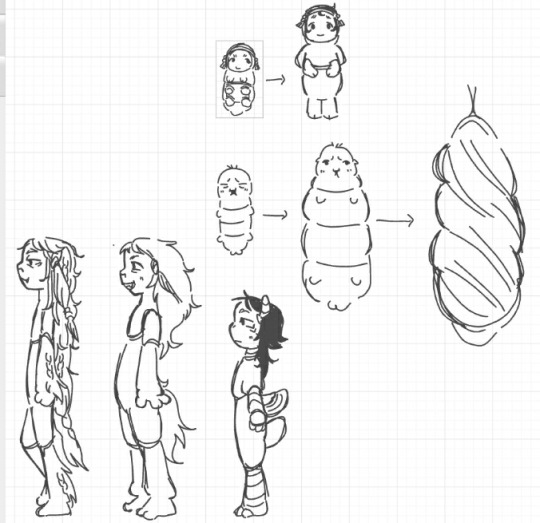

some context, Seam is one of my cosmo ocs, shes not exactly dead but she is in eternal slumber, which with the process of cosmosis caused her cells to gain sophonce making her kinda like a living galaxy (shes INCOMPREHENSIBLY big)
in turn alot of her parasites and pathogens also gain sophonce one of which are mentioned in the third drawing
if she ever wakes up itll be a world ending event within her body and shortly kill her after 😅

this creature is from another universe, which is my only other universe.. i have a bad habit of stuffing alot of different stories into the same universe lol it limits my creativity sometimes because i feel the need to follow the rules i already established in my headworld
i saw the character (Isaac) in a dream, along with the place he lives in, its quite interesting

the basic overview building i saw in my dream im not very good at architecture or buildings for that matter but i tried my best to map what i saw
basically hes spliced with the creature in the image to make a vaccine for a disease they spreaded onto humans wiping out almost the entire population of humans
i didn't see the creature in my dream all i know it was aquatic somehow because Isaac is amphibious so i took inspiration from flatworms, it looks the same back to front and i liked the unsettling eye spots flatworms have

another character from this universe, theyre one of Isaac's close friends, i did see them in my dream
i know theyre stiff but as i mentioned before i just like drawing my characters like this because i like lining up my ocs like dolls when i make references
#art#digital art#small artist#worldbuilding#creature design#speculative evolution#speculative biology#digital artist#character design
24 notes
·
View notes
Text
The Mithril Archipelago, more colloquially known as the Pious Pools, refers to a cluster of islands to the southwest of Tetrahex an orn and some groon out from the shore. When seen from above, the island chain appears to form a large hand rising from the sea, with the ‘palm’ being the largest of eight.
Despite being collectively referred to as the Pious Pools, the most notable tide pools are largely clustered on the eastern side of the palm, index, and middle islands, while the largest natural springs are located on the thumb.
All of the islands in the archipelago are quite rocky, but the hotspot at the base of the thumb has historically produced a notable number of amphibious mecha and triple-changers with alt modes suitable for both the cliffside environment and the warm Mithril Sea.
Most locals live in the center and southeast portions of the palm closest to the thumb, though there are smaller fishing and tourism based areas on the index, middle, and ring fingers. The Pious Pools are well-known for the peculiar traditional architecture of the area, which comes from a mix of the islands originally being settled as a hermitage and simple practicality; most buildings and residences are tucked inside and built out of the natural caves formed by sea erosion over millions of years, or otherwise secured into the sheer cliffs in tiers!
If you wish to visit the ruins of the hermitage, the Little Temple (also known as the Conduit or the First Temple,) please be aware that there is an active and ongoing restoration project underway to restore the damage that occurred under the Functionist Mandate of Singularity. There is a priest in residence and dormitory space available to those devoted or simply curious. Liturgical services are held every orn at 08.45j and end of decacyle services at 17.15j/18.15j depending on the season.
The Iaconian Academy of Science and Medicine has recently reestablished the historical outreach campus of the Grand Archives in the curve between the middle and ring fingers with the help of Deltaran Hospital and Optimus Prime, who has taken up semi-permanent residence on the islands to assist with preservation and archeological efforts.
The tips of the index and middle fingers are recognized by Primal Authority as a preservation site and mechanimal sanctuary. Permits are required for hunting and fishing in the area.
The two islands that make up the smallest finger are generally considered to be uninhabitable, as the middle island and the spit of land that bridges it to the palm is flooded each day at high tide, and the last of the two has recently become the source of a great many strange sightings and ghost stories. Visitors are highly discouraged from lingering.
13 notes
·
View notes
Text
The Dogon People who are Naturally Specialize in Astronomy
The Dogon people are a community of people living in present-day Mali. Their original point of migration to their present locale is not known, however, some scholars have traced their ancestry to the ancient Egyptian empire. They are about 300,000 in population occupying about 700 villages with an average of about 500 inhabitants per village.
The Dogon people possess a rich oral history and knowledge of astronomy, which dates as far back as 3200 BC. According to the oral literature of the Dogon tribe, the star named; ‘Sirius A’ (the brightest star in the night sky with a bluish tinge) has an invisible companion star scientists have named ‘Sirius B’. This companion star is not only invisible to the naked eye but also completes a trip around ‘Sirius A’ every 50 years.
The story of the Dogon people of Mali is a remarkable tale of cultural preservation and astronomical knowledge. The Dogon people are an ethnic group that live in the Bandiagara Escarpment in Mali, West Africa. They are known for their unique and complex cosmology, which includes detailed knowledge of the stars and the universe. According to Dogon mythology, their ancestors were visited by a race of beings from the Sirius star system, known as the Nommo.
The Nommo were described as amphibious creatures who brought knowledge and culture to the Dogon people. They taught the Dogon about the movements of the stars, the nature of the universe, and the importance of harmony and balance. The Dogon have a detailed knowledge of astronomy, including the location and movements of the stars, the moon, and the planets. They have been able to accurately predict astronomical events, such as eclipses and the cycles of the moon, for centuries.
Their astronomical knowledge has been passed down through oral tradition and is considered to be among the most sophisticated in the world. The Dogon are also known for their unique architecture, which includes houses built into the cliffs of the Bandiagara Escarpment. These houses are made of mud and stone and feature intricate carvings and designs.
Despite the challenges of modernization and globalization, the Dogon have managed to preserve their cultural traditions and way of life. They continue to practice their cosmology and hold onto their ancient knowledge, even as the world around them changes.

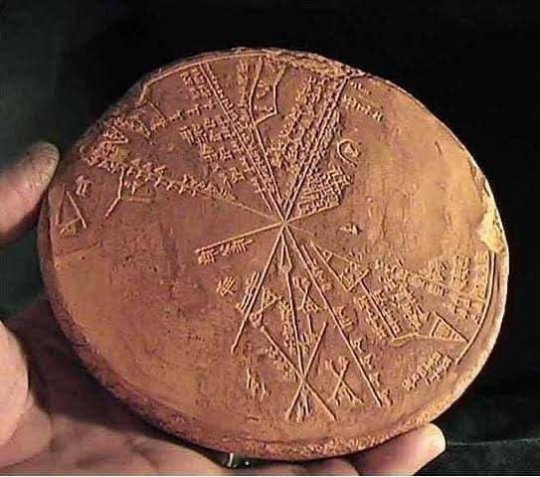
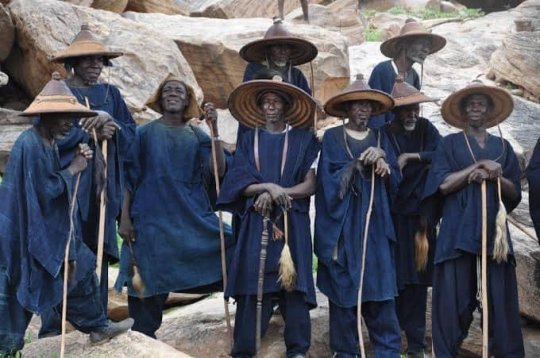
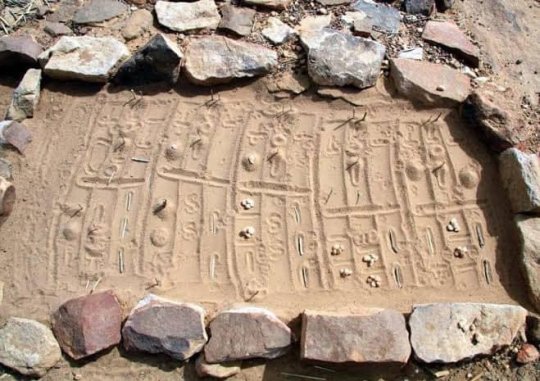
The story of the Dogon people is a testament to the power of cultural preservation and the importance of honouring and respecting the knowledge and traditions of indigenous peoples. Their astronomical knowledge and unique architecture serve as a reminder of the richness and diversity of African cultures, and their story inspires us to learn more about the history and traditions of Africa and its peoples. #Africa
Joe_Bassey. - twitter
·
11 notes
·
View notes
Note
I have Sumdac info I would like please. Species, planet, & abilities for the following. DJ Syko: Heavybass, Big Clamp, Marznake, Wingbeat. Synthia: Omega-X, Hive Bass. Secta: Ferrodens, Prementicimex, Colligendis, Foxmica. Sonia: Fleetfoot, Streetburn, Sonic Boost. Soria: Tritanium, Theroziner, Nagaoboa. Sabrina: Hornbrow, Tryoptic, Skolgrin, Handigal, Slithemirror, Scornitho. Scraplette: Piledriver, Quickcheck, Undergrunt. Sorry it's 25 whole aliens that's a lot but I crave knowledge please.
It's cool that you crave knowledge. Just know you may face... repetition here and there.
Heavybass - Chumgartu - Ramtharag
Noted Abilities: Super-Strength, Amphibious
Big Clamp - Macra (Sentient) - Macratus IV
Noted Abilities: Great Size, Toxin Consumption
Marznake - Vypirian - Vypiron (though scans indicate that Marznake in particular appears to be a Martian subspecies)
Noted Abilities: Muscular Tail that can crush with great strength
Wingbeat - "Gargoyle" - Unknown
Noted Abilities: Flight, Rock-Hard Skin
Omega-X - Sentient Virus Manifestation - Station Yggdrasil
Noted Abilities: Electromagnetic Interference, Information Absorbtion, Energy Blade Generation, Flame Cannon
Hive Bass - Lekgolo Assembler - Svir 5 (local name Te)
Noted Abilities: Hive-mind control over multiple Lekgolo, Can operate machinery by crawling inside and assimilating it.
Ferrodens - Dynasti - Coelop Terra
Noted Abilties: Energy Projection using giant horn
Prementicimex - Lucanidi - Coelop Terra
Noted Abilities: Crushing horns
Colligendis - Satiri - Coelop Terra
Noted Abilities: Can magnetize any metal, uses this power to create giant junk balls
Formica - Formixa - Hymenosia
Noted Abilities: Super Strength, Seemingly Instinctual Architectural Knowledge
Fleetfoot - Kitspeedune - Geatstar 9
Noted Abilities: High-Speed movement, Emits blasts of water from arm-mounted reserviors that emit out of index fingers
Streetburn - Cybertronian (Cycleformer) - Cybertron
Noted Abilities: Mechanical Mimicry
Sonic Boost - Aerophibian - Aeropela
Noted Abilities: High-Speed Flight, Neuroshock Lasers
Tritanium - Metaloceras - Terradino
Noted Abilities: Metal Horn Structures, Super Strength
Therizoner - Hork-Bajir - S5 RG-12578-4 (local name unknown)
Noted Abilities: Arm-mounted blades
Nagaoboa - Vypirian (standard) - Vypiron
Noted Abilities: Muscular Tail that can crush with great strength
Hornbrow - Daemonian - Daemos
Noted Abilities: Imposing Aura, Above Average Strength
Tryoptic - Artylian - Titanios
Noted Abilities: Mana Storage and Manipulation
Skolgrin - Kolstani Simulaform - N/A (Artificial Lifeform)
Noted Abilities: Deriving energy from Negative Emotions
Handigal - Digitator - Titanios
Noted Abilities: Multiple Manipulation Limbs, Mana Manipulation
Slithemirror - Titanian Basilisk - Titanios
Noted Abilities: Form Mimicry, Mana Consumption
Scornitho - Titanian Strigiform - Titanios
Noted Abilities: Extensive Stretching, Flight, and uncanny ability to fit into any space larger than head.
Piledriver - Cybertronian (Minicon) - Prion(?)
Noted Abilities: Machine Mimicry, Tool Generation
Quickcheck - Citrakayah - Chalybeas
Noted Abilities: High-Speed Movement
Undergrunt - Cathonian (Volenoid) - Cathon
Noted Abilities: Mustache-Based Dasyokinesis
4 notes
·
View notes
Note
Oc lore please
*insert holding knife & fork like toon*
YOOO LFG
*ahem* I'm normal now
So, uh, I've got a lotta oc lore, so this is gonna be a long post that I'm gonna break into chunks
Toon mystery-verse (one of my favs)
The main players in this one are Millie Grey, Benson Elwood, and Percy De Luca (tho I if I make this idea a full webcomic, I'm gonna include some of @naviofortido's ocs as major players too)
The story is about these main three looking into mysterious happenings and alleged cult activity in their town (mostly Millie and Benson being dragged into it by Percy, who's a major enthusiast about that kinda stuff). After an incident while they're investigating stuff, Millie winds up with the ability to turn into a cartoon character, and she and Benson wind up having to keep it a secret from Percy (because how tf do you explain that) while continuing to try and figure things out.
Extra tidbits: Millie and Percy are very gay for each other (making Millie hiding toon shenanigannery even harder), Benson likes prog rock and nearly killed Millie when she called Roundabout "the song from JoJo", the idiot trio had a movie night one time and Percy and Benson accidentally traumatized Millie by showing her An American Werewolf in London (stuff like that horrifies her)(she spent half an hour in the bathroom throwing up), the gang's mains in Mario Kart are Bowser (Millie), Wiggler (Benson), and Mii (Percy), Benson gets tooned later on, I'm running an ask blog exploring one of the major antagonists' origins (@archive-askblog), and one of the other major antagonists is a bitch (gotta do more with her soon)
Sci-fi stuffs (been violently rotating recently)
Haven't really figured out a plot yet, but I have figured out lots of worldbuilding, such as some aspects of alien cultures, and splitting humans into 2 different factions (the nature entwined and primarily agriculture and exploration focused Nations of the Free Planet, and the wealthy Sovereign Union of Mars)
Alien species (that I have yet to digitally draw -v-;):
E'Ymahi, kinda built like a llama with gorilla hands and crab eyes, they're very artsy and get along really well with the NotFP, and one of the first alien species humans have made contact with. Technologically in their equivalent of the 1960's before humans made contact.
(notebook doodles I need to digitize +a clay doll I made)
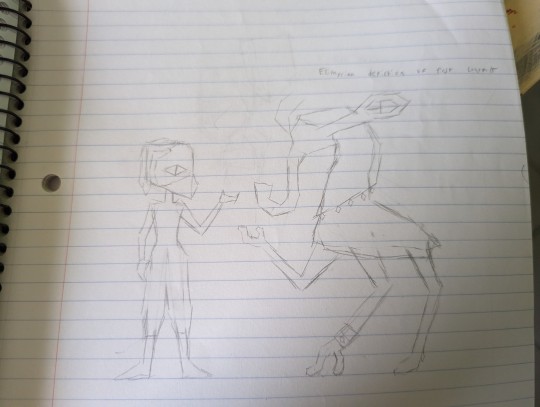
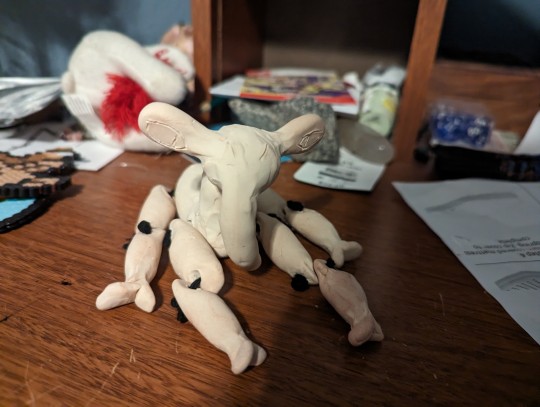
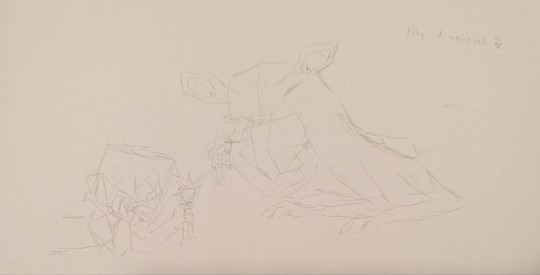
Temi, the E'Ymahi already had some crablike features, but these guys are very crablike. They don't like either faction of humans much, thinking the NotFP are gross and uncivilized for living with nature (a lot of their art and expression comes from cold and geometric architecture), and the SUoM are cruel to their workers and obnoxious in their gaudy displays of wealth. They were the first aliens humans made contact with, but they took one look at humans and were like "Fuck this".
(notebook doodles)

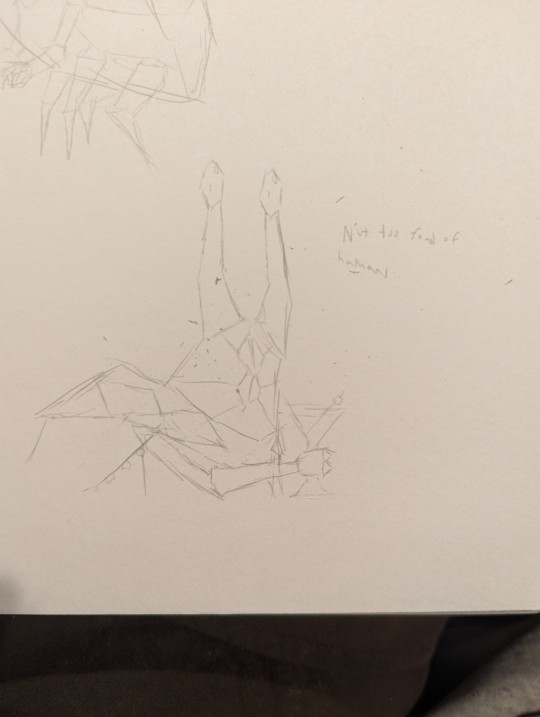
Skarmovian, towering, warmongers who resemble a combination of a shark and a minotaur. They're not really affiliated with humans, mostly because they don't care. Their religion is based around chaos, and it's a major ritual to eat those who died in battle. (Made these guys in Spore when I decided it'd be funny to kill everything, but then they stuck in my brain and are a part of this thing)(the cannibalism thing came from Spore too)
Don't have any notebook doodles, but I do have the original Spore creature!
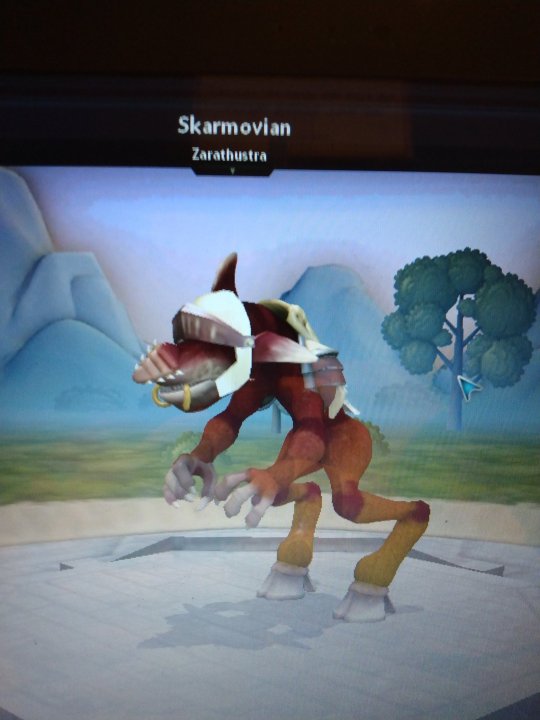
Ovistrite, centaurian and amphibious creatures, they are a very wealthy species and get along very well with and recently joined the SUoM.
(also originated from Spore and wound up sticking, they're from my first ever playthrough of the game)
The notebook doodles are fairly recent, as I was thinking about them recently

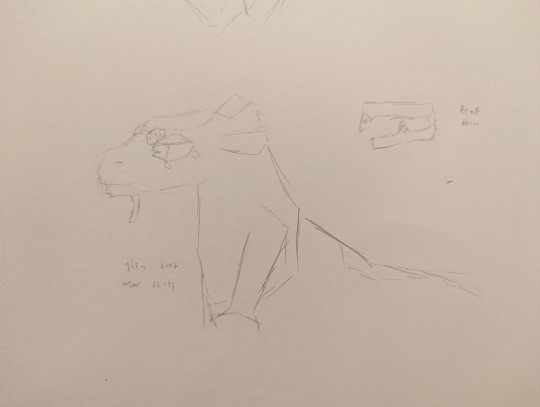

What if Terminator role reversal?
Don't have much plot figured out for this one, but it's basically what it says on the tin. I was watching Terminator with my dad and I thought to myself "What if there was a story about humans trying to overthrow robots, but they were in the wrong and the robots were actually taking better care of the planet than they were)
I've figured out the basic beats and characters tho!
Basically, after rich people kinda fucked up the planet and the surviving members of humanity isolated themselves in bunkers, robots started tending to the planet, thousands of years later, the bunker humans try to destroy the robots, because one of the major bunker human leaders (a member of the wealthy elite who remained from the apocalypse pretending to be a god by keeping themselves alive with cybernetics) wants control of the planet again. The two major characters are Fern, a robot shepherd, and Albron, a human from the major bunker tribe, who rebels after learning the robots aren't evil and that they've been lied to.
Random tidbits
The robot town I wanna focus on is named Megan, and the town worships a decrepit service robot (who was owned by someone named Megan, hence the town name) as a deity of prophecy
The robots are named after plants and artists (in English, as language hasn't evolved for them due to being computers), and the humans are named after scientists, with their names being somewhat jumbled and corrupted to kinda represent the evolution of language, examples include: Albron (Albert), Niklai (Nikola), and Eldson (Edison)
(bonus note, Eldson is the false god, and is exploitative of Niklai :) )(edison can suck an egg)
#long post#ocs#my ocs#stimmed so hard seeing this notif#eat well my good chum#cw emetophobia#cannibalism mention#<-forgot to tag those...
2 notes
·
View notes
Text
News Roundup 8/23/2023 | The Libertarian Institute
Here is your daily roundup of today's news:
News Roundup 8/23/2023
by Kyle Anzalone
Russia
On Sunday, Denmark and the Netherlands became the first countries to pledge they will provide Ukraine with US-made F-16 fighter jets following formal US approval of the transfer. AWC
A Ukrainian military official suggested to The Washington Post that Ukrainian forces are not documenting where they’re using US-provided cluster bombs in Ukraine despite assurances the Biden administration said it received. AWC
Warsaw plans to buy nearly 100 Apache attack helicopters manufactured by Boeing for $12 billion. Until Poland receives the helicopters, the US will provide Apaches to its NATO ally. The Institute
US and Western officials speaking to The New York Times blamed Ukraine’s struggling counteroffensive on Kyiv’s tactics, saying Ukrainian troops are too spread out. AWC
Polish President Andrzej Duda said Tuesday that Russia has been moving nuclear weapons into Belarus and said the deployment changes the “security architecture” of the region. AWC
Airports in Moscow temporarily halted service for the second day in a row on Tuesday as Ukrainian drones again targeted the region, part of Kyiv’s strategy to bring the war to Russian civilians. AWC
The Russian Defense Ministry said Tuesday that its forces destroyed a US-made military boat carrying a Ukrainian assault team near Snake Island in the northern Black Sea. AWC
China
On Monday, Australia’s biggest warship participated in drills with the Philippines and the US in the disputed South China Sea as part of Canberra and Manila’s first-ever bilateral amphibious exercises. AWC
China on Monday hit back at the US, South Korea, and Japan after the leaders of the three nations accused Beijing of “dangerous and aggressive” behavior in the South China Sea. AWC
Korea
North Korean leader Kim Jong Un oversaw a cruise missile test while aboard a naval ship on Monday. Concurrently, the US and South Korea began yet another series of military exercises which Pyongyang views as rehearsals for war and regime change. The Institute
Middle East
Israeli airstrikes near the Syrian capital of Damascus late Monday wounded at least one Syrian soldier, Syria’s SANA news agency has reported. AWC
Human Rights Watch (HRW) reports that Saudi border forces are systematically murdering migrants attempting to cross into the Kingdom from Yemen. The monitoring group said killing refugees had become an official policy of Riyadh. The Institute
Africa
US Africa Command (AFRICOM) said in a press release last week that it launched an airstrike in Somalia on August 15. AWC
Algeria’s national radio reported on Monday that France is planning a military intervention in Niger if Nigerian President Mohamed Bazoum is not released by the junta that ousted him in a July 26 coup. AWC
Read More
2 notes
·
View notes
Text
I dream of the day when cryptozoology crosses the fuzzy line into science and becomes the hybridisation of ecology and cultural anthropology that it ought to be, studying folklore as a record of local lived experience to be taken seriously in ecological studies. If archaeoacoustics can shift from leylines and mystical frequencies into modeling the resonant behaviour of historical architecture to reconstruct what music and speech would have sounded like when they were new, other pseudosciences can too. :P
I have my own favourite examples (usually because no one's ever heard of them so they lack the baggage associated with yeti or, gods forbid, Mothman):
The Bili apes were initially reported as an unknown species of primate or possibly some kind of implausible gorilla-chimp hybrid, but further research did determine that there is a wide local range of chimpanzee behavioural adaptations, including groups that act like gorillas in specific ways.
The buru is less conclusive - it's a crocodile-like swamp creature reported in the Apatani foundational myth to have inhabited the Ziro Valley in northeast India before the Apatani settled there. The name is similar to words used for crocodiles in a number of other southeast Asian languages (buaya), but the description may align better with an isolated population of monitor lizards. It's interesting to me either way, because the folklore explains its extinction as both quite recent (by the late 1940s) and mundane (the Apatanis claim to have destroyed its habitat to farm rice, and survivors escaped to underground springs but ultimately did not form a stable population).
The only known native mammals on New Zealand are assorted bats, which makes the waitoreke a curious abnormality - a small amphibious animal like a cat-sized otter, whose ability to survive unnoticed in the forests and coasts is made more plausible by the infamous reports of a cryptic population of moose doing the same thing. It supposedly predates the introduction of other small invasive mammals (as well as the moose); the only physical evidence was a pelt which resembled a quoll, which isn't an obvious fit for being aquatic but had centuries in which it could have been introduced. And the only remotely-similar native species was the St Bathans mammal, which is only known from a fossil from the Early Miocene; it seems superficially unlikely to have survived and evolved in secrecy for the past 16 million years, but it would be very cool if it had, since it would be the only extant mammal group outside of the placentals, marsupials, and monotremes.

43K notes
·
View notes
Text
#climate change#amphibious housing#elizabeth english#architecture#future#emily anthes#currently reading#currently thinking about#new yorker
1 note
·
View note
Text
The Puppet and the Mind: A Scientific Analysis of Galarian Slowking’s Neurochemical Dominion

Introduction
In most parasitic relationships, the host suffers, and the parasite thrives. In a few rare cases, the two evolve toward mutual benefit. But in Galarian Slowking, we see something far more radical — a complete neurological inversion, in which the parasite not only survives, but becomes the brain.
This article examines the biochemistry, anatomy, and neurological architecture of Galarian Slowking, a species that redefines parasitism by allowing the invader to drive — and even think — on behalf of its host.
From Brain Food to Brain Control: Shellder’s Ascendancy
Unlike in Slowbro or regular Slowking, where Shellder acts as a passive toxin gland or neurochemical enhancer, in Galarian Slowking the Shellder has fully overtaken control of the host’s central nervous system.
The Shellder’s shell encases Slowking’s entire upper skull.
Neural tendrils likely penetrate the cranial meninges and cerebral cortex.
Motor commands, cognition, and even vocalizations are now controlled by Shellder, not the host.
This is not an evolution of the host — it's the awakening of the parasite.
The Green Orb: Psionic Amplifier or Neural Core
Mounted prominently on the Shellder’s forehead is a green crystal-like organ, replacing the red gem seen in regular Slowking.
Likely functions as a neural stabilizer, enhancing signal fidelity between host and parasite.
May serve as a psionic organ, generating:
Telepathy
Psychic hallucinations
Emotion-based projection
May also assist in modulating or coordinating toxin-based mental effects.
Biological parallel: Electric eels and rays use electrogenic organs to communicate or paralyze — this may be a psychic analogue.
Biochemical Alchemy: Fluid Synthesis from Thought
One of Galarian Slowking’s most distinctive adaptations is its ability to produce specialized toxins from its diet and internal chemistry:
Galarica berry-derived compounds are metabolized and combined with Shellder’s venom.
This hybrid venom is altered on demand, forming a variety of fluids with:
Paralytic
Hallucinogenic
Neurodisruptive
Or even mind-controlling properties
These fluids are expelled through the horns of the Shellder shell, which act as chemical dispersal valves.
Real-world analogue: Bombardier beetles mix reactive compounds inside their abdomen and spray them. Spitting cobras eject directional venom jets. Here, the principle is taken further — mixed in a conscious brain and projected psychically.
Who Is In Control? The Slowking Body as Puppet
While the Slowking body remains intact, mobile, and metabolically active, it is no longer autonomous.
All decision-making is Shellder's.
The host’s limbs, voice, and eyes respond to external commands.
The host's original brain may still function partially, but under constant neurochemical suppression.
Real-world equivalent: Toxoplasma gondii rewires rodent behavior; Cordyceps fungi take over insect motor systems. But no known parasite achieves cognitive dominance — Galarian Slowking stands alone.
The Horns: Glands of Power
The large, curved horns are not ornamental — they are hollow venom ducts.
Each horn may store a different fluid mixture.
Directional secretion allows for:
Precision toxin release
Area-of-effect misting
Or projected psychic-aerosol combinations
This is chemical warfare by design, built into the skull of a symbiotic being.
Conclusion: The Shell That Thinks
Galarian Slowking is the final and most chilling phase of this evolutionary arc. It is no longer a Slowpoke enhanced by Shellder — it is Shellder evolved into a mind, piloting a powerful amphibious body, concocting alchemical fluids from thought, and communicating through venom.
It represents a kind of bio-psionic convergence:
Symbiosis becomes possession.
Venom becomes language.
And the host becomes the shell for a new intelligence.
This is the ultimate predator: silent, psychic, and venomously eloquent.
0 notes
Text

Introduction: The Rise of Adaptive Architecture Architecture is no longer static. The built environment is evolving towards dynamic and adaptive systems that respond intelligently to changing conditions—whether environmental, social, or technological. Known as Adaptive Architecture, this emerging trend redefines how we experience spaces, optimizing comfort, sustainability, and efficiency. This article delves into the principles of adaptive architecture, its technological backbone, notable global examples, and its potential impact on urban landscapes, backed by research from four verified sources. 1. What is Adaptive Architecture? Adaptive architecture refers to buildings that modify their form, function, or energy performance in response to real-time conditions. Unlike traditional structures, these buildings integrate sensors, artificial intelligence (AI), and advanced materials to adapt dynamically. According to a 2023 report by the International Smart Cities Research Institute, adaptive buildings can reduce energy consumption by 30-50% through real-time environmental adjustments, significantly enhancing sustainability. Key characteristics of adaptive architecture: - Dynamic façades that alter transparency, ventilation, or shading based on sunlight and weather. - Morphing structures that expand or contract based on occupancy and purpose. - Self-regulating energy systems that adjust consumption according to real-time demand. - Smart materials that react to temperature, pressure, or motion. kinetic façade 2. Cutting-Edge Technologies Driving Adaptive Architecture A. Kinetic Façades and Smart Surfaces One of the most striking applications of adaptive architecture is the kinetic façade, which moves in response to external stimuli. - Al Bahr Towers (Abu Dhabi): The building’s innovative shading system features a mashrabiya-inspired kinetic façade that adjusts its panels according to sun exposure, reducing cooling loads by 50%. - The Media-TIC Building (Barcelona): Features an ETFE (ethylene tetrafluoroethylene) membrane that changes opacity based on heat levels, enhancing energy efficiency. B. Artificial Intelligence & Internet of Things (IoT) in Buildings AI-driven adaptive architecture is revolutionizing urban planning. The Edge (Amsterdam) is one of the smartest buildings in the world, where an AI system: - Adjusts lighting based on occupancy. - Directs employees to available workspaces in real time. - Monitors and optimizes airflow and temperature, reducing energy consumption by 30%. C. Self-Healing and Shape-Shifting Materials Breakthroughs in material science are enabling structures that repair themselves or change shape on demand. - MIT’s Self-Healing Concrete: Infused with bacteria that produce limestone, it can automatically seal cracks, extending building lifespan by 30%. - Shape-Memory Alloys: Metals that return to pre-set forms in response to temperature changes, allowing buildings to reshape in extreme conditions. 3. Adaptive Architecture in Action: Notable Global Examples A. Dynamic Climate Adaptation: The Tower at PNC Plaza (USA) Dubbed the world’s greenest skyscraper, this Pittsburgh-based tower: - Features a double-skin façade that opens and closes automatically based on air quality. - Reduces the need for artificial cooling and heating by 50%. B. Responsive Public Spaces: The Shed (New York City) This cultural center features a telescopic outer shell that expands and contracts to create adaptable spaces for exhibitions, concerts, and performances. C. Floating and Amphibious Housing: Maasbommel Floating Homes (Netherlands) Designed for flood-prone areas, these homes can rise and float as water levels change, preventing damage from extreme weather events. 4. The Future of Adaptive Urbanism: How Cities Will Change The integration of adaptive architecture in cities is already reshaping urban planning and infrastructure development. By 2050, experts predict: - 30% of new urban buildings will incorporate AI-driven adaptability. - Smart climate control systems will reduce urban heat islands by 20%. - Floating and retractable infrastructure will mitigate the effects of rising sea levels. Cities like Singapore, Copenhagen, and Tokyo are already investing in adaptive design, focusing on resilient, responsive, and sustainable urban landscapes. https://archup.net/what-is-adaptive-reuse-architecture-and-why-should-you-care/ Conclusion: The Adaptive Future is Now Adaptive architecture is not a distant concept—it is happening now, reshaping how we build, interact with, and experience spaces. By merging smart technologies, AI, and innovative materials, adaptive buildings promise a future where structures are no longer static, but alive, evolving, and in harmony with their environments. As cities grow and environmental challenges intensify, how we implement adaptive architecture will determine whether our built environments remain rigid—or flourish as living, breathing ecosystems. Want to Stay Relevant in Architecture? Become an Adaptive Reuse or Renovation Expert 🚀 Will adaptive architecture become the new standard in global city planning? Only time will tell. Read the full article
0 notes
Text
I Read Project 2025, So Here's A Rundown I Guess: Part 3.4
Idk if this counts as political, but I'm just reading the stupid book online and putting down what it basically says and some other stuff I huess. (it could get political I guess? Idk. Just kinda wanted to make these posts since I'm reading the book and I kept getting annoyed with people just saying what the book says instead of writing down exactly what it says and what page to find it on)
(That's not saying I won't do the same thing, but for some things I'll rewrite what it says unless it just needs to be summarized. I will have page numbers though)
(also, if this stuff does go into effect, I will be fearing for my life and the lives of many others for the effects this could have on people. for lgbtq, minorities in religion, race, and ethnicity, and those who are poor. this will effect everyone and a lot of people should be afraid of it. that is not be getting political, that is me saying that this is a scary plan meant to give powerful people even more power)
(also, if you want a faster rundown than waiting for me to give shitty interpretations of this, go to the wiki here. it sums it up pretty well, but it doesn't state everything.)
Department of Defense Reforms -
U.S. Marine Corps:
Eliminate all United States marine corps law enforcement battalions, transform at least one marine infantry regiment into a marine littoral regiment (for islands), reduce the size of remaining infantry battalion, continue to get rid of m1 Abram's tanks, eliminate the majority of tube artillery batteries, reduce the number of advanced amphibious assault vehicles and the number of their replacements, increase the number of rocket artillery batteries, increase the number of upgraded light armored vehicle companies, increase the number of unmanned Aerial systems and anti-air systems, develop long-range strike missiles and anti-ship missiles for the corps, modernize USMC infantry equipment all to get rid of less relevant equipment to modernize relevant equipment (Pages 115-116)
Make the USMC combat arms ranks the same as the U.S. army's, create better incentives to keep talented junior ncos (high ranking officers) especially in the infantry, reduce unnecessary deployments to increase the ability for military personnel to more easily finish primary military education (Pages 116-117)
Develop and produce light amphibious warships to support more amphibious operations especially in the pacific, maintain between 28 and 31 large amphibious warships instead of the 25 that is in the current navy shipbuilding plans and the 38 that was in the plans before 2020 (Page 117)
U.S. Space Force:
Reestablish offensive capabilities to what they were before the Biden Administration changed them and make it harder for enemies to make a successful first strike against U.S space assets, restore architectural balance to restore deterrence dominance, rapidly expand space control capability to provide an early warning of an enemy attack, only seek space arms control and rules when they in the interests of the U.S. (Pages 117-118)
Declassify some information about terrestrial and in-orbit space capabilities that threaten U.S. controlled space areas to be able to counter competitors offensively (Page 118)
Restructure from “unity of effort” to “unity of command” (whatever that means), lead the government’s development of a clear declaration that the U.S. will operate as it pleases in space, end the current study phase for offensive space capabilities to speed up concept development, transition to a methodology to maintain aggressive timelines with greater engineering rigor to sustain, support, and fully integrate space operations, increase the number of general officer positions, explore the creation of a space force academy to attract more aero-Astro students, engineers, and scientists, and to develop more astronauts (Pages 118-119)
U.S. Cyber Command:
Separate USCYBERCOM from the National Security Agency, Conduct effective offensive cyber operations, expand defensive cyber operations, end USCYBERCOM’s participation in federal efforts to eliminate the perception that DOD is engaging in partisan politics (Pages 119-120)
Accelerate the integration of cyber and electronic warfare capabilities, mandate that development teams will include coders, soldiers, aircrew, and sailors with experience at platoon level, “break the paradigm of cyber authorities held at the strategic level” (idek), increase cyber resilience by protecting systems such at Nuclean Command, Control, Communications Network, and the Air Force’s Cyber Resiliency Office for Weapons Systems, expand coordination to joint operations with allies, implement the DOD’s abilities to have visibility of cyber incident reporting to support tactical, strategic, and military strategies for response (Page 120)
Update the National Security Strategy to define the DOD roles and responsibilities, apply traditional deterrence strategies and principles for using cyber retaliation in foreign cyberattacks against U.S. infrastructure and citizens (Page 102)
1 note
·
View note
Text
A War for Peace, Legacy, and the Future (draft 2)
Infrastructure That Fights Back: Buildings as Weapons The architecture of Isla Esperanza was like nothing the world had ever witnessed. Buildings had been designed to be alive and evolve, to repair themselves, and to change structure according to the demands and the threats they identify. Fitted with AI cores and nanotechnology, it did not only mean buildings; it meant participants in the war. Walls might bulge, sway or even crumble to imprison enemies, rooftop guns and concealed weapons might pop up in combat. Obvious buildings might morph into defensive fortifications, mobile road blocks, or command centers to meet the tactical need.
At the center of this marvel of architecture was the technology of robot-contoured construction: an architecture that allowed robotic drones to reshape and rebuild infrastructure in real-time. This allowed the warriors to alter their environment to suit their needs, constructing ambuscades or obstructing enemy advances with constantly shifting buildings. Some of the buildings even acted as "combat architects," operating robotic arms and drones that rapidly could repair or construct out armed extensions like a turret. Hydro-powered energy grids lay beneath the island, supplying these smart buildings with limitless energy, and photovoltaic surfaces absorbed sunlight to recharge hidden drones patrolling the airspace. Living walls of engineered algae and vines served as both barriers and environmental filtering systems, purifying the air and the water while shielding the warriors.
A Fluid World: Transportation Across Land, Sea, and Air The transportation of Isla Esperanza was very fluid in across all terrains—land, sea, and sky. With amphibious capabilities, every vehicle on the island could adapt its environment in real time. Armored hovercraft, skimming water and land alike, flew modules that transported supplies and warriors across the battlefield. Some could morph mid-flight into combat units with energy cannons or EMP bombs that could knock out enemy electronics. Other modules morphed into med-bots, carrying wounded fighters to safety or directly delivering medical supplies into combat zones.
Underwater, fleets of biomechanical submarines in the shape of marine animals patrolled the coast with organic exteriors camouflaging them in the depths. Landwards, self-driving modular transports carried troops, weapons, and equipment, propelled by AI that could reroute through unpredictable terrain or even self-destruct if captured by the enemy. All these vehicles communicated with the island's infrastructure, making transport merge with tactics. Some could log onto the kids' digital dome, even practicing piloting through VR simulations that synced with live battles.
Air mobility was just as fundamental--stealth gliders and self-guiding airships patrolled the skies, providing logistics and intel feeds. Some fighters flew exo-gliders--winged armor attired with adaptive jet propulsion, allowing them to fight on both land and in the air. The transportation infrastructure was fluid, fast, and unpredictable, making it essentially impossible for an enemy to gain an advantage over the other.
A Digital Dome of Learning and Strategy The digital transparent zone where the children were kept was more than a safe haven; it was an edutainment center and command center. Suspended in the middle of the island, the dome was built from a translucent force field which could regenerate if breached. Inside, the children learned by watching what was happening on the battlefield in real-time by augmented reality overlays. Every vehicle, drone, and building system was plugged in to the dome and fed data into the children's neural interfaces, allowing them to interact with battlefield decisions and provide tactical suggestions to their mothers. In this way, war became both education and test—a proving ground where skills were developed by children to be used eventually for leadership purposes.
The dome became the command center, where the children assumed minimal roles in the war. They hacked enemy drones, destroyed supply lines, and coordinated an ambush or two, working alongside their mothers to learn not just to fight but to lead. The warriors believed that the witnessing of results of their decisions—in both victories and losses—served a crucial purpose in building a world in which peace was cherished and war understood.


0 notes
Text
Alright, I wanna throw my hat into the ring and share ideas I have for lizardfolk:
•Lizardfolk are uniquely fit for semi-aquatic architecture, incorporating water heavily into how they make their civilizations and settlements. Real life has plenty of unique examples of how humans use water in this kinda way, from canal networks to floating terraces. A semi-amphibious race can do a heck of a lot more with these kinds of concepts. •Many harsh ideas about the lizardfolk are actually the issue of people unable to recognize that their own worldview is not universal. Lizardfolk are seen as emotionless and working purely on instinct because most of the lizardfolk outside groups meet are often hunting groups focused on the survival goal of getting food. Ideas of them being uncivilized is because Lizardfolk are practical minded with how they do certain things, and don't bother with made up social norms and customs because to them, it's much more valuable if no time is wasted on pointless information. Despite this, Lizardfolk can be very playful and humorous, its just that they usually save these behaviors for when they feel safe and comfortable, which usually isn't how they feel finding a bunch of random adventurers wandering in their territory. •You want a unique role to put lizardfolk in? Why not incorporate Lizardfolk in River and water Trade. Trade is important for any group and nation, and water bodies are the most efficient way for older societies to move valuable goods. Lizardfolk, experts in navigating rivers, lakes, and other bodies of water, would have likely been in contact with these entities the moment they started showing interest in their waters. Many lizardfolk offer their services as guides, guards, and sometimes act as traders themselves. This also allows us to use Lizardfolks as enemies, except we trade in "Savage tribal" for "Opportunistic river pirate". •Playing with tropes, Lizardfolk are indeed often found in ruins, except this is something they purposefully cultivate at times. Being closely tied to nature, Lizardfolk are fascinated with the way nature reclaims man made things, and don't mind watching things that they've built be destroyed and reclaimed by the environment, so long as they can still use the area without much issue. Entire lizardfolk cities are completely covered in plantlife and rubble from damage accumulated over decades, becoming beautiful naturally formed gardens that rival even the grandest of Elven kingdoms and fae landscapes.
Hey friends, I was thinking of taking a crack at doing an oft requested "monsters reimagined" for lizardfolk in the next little while, but I found myself stalled out on creating an alternative pitch for their lore.
The problem is that there's so little to work with in the " Ignorant primordial savage" role that they've been pigeonholed into that I'm having genuine trouble finding inspiration.
As such, I figured I'd encourage you all to write your own favourite take on the lizardfolk in the replies/comments, and we'll see if we can't brainstorm our way to an awnser.
Here's some of my own thoughts to get you started:
Lizardfolk as they are presented primarily exist to fufill the role of stock primitive antagonists, a one step more fantastical version of the jungle dwelling cannibals often encountered like pulp heroes like Indiana Jones/Doc Savage/Conan the Barbarian.
In many ways they are the epitome of the "fill in the blank baddie", with everything from their culture to their religion to their motivations being wholly based on the fact that they're lizardy lizards who like to do lizard things and could never be anything but. This is flat and boring, and needs to change if we have any hope of doing something with them.
The whole "uninterested in knowledge", " think with their stomachs", "don't have emotions, just instinct" is one of d&d's most glaring examples of biological determinism. It assigns lizardfolk the concept of "spear chucking savages" and then works backwards to justify why they remain savage while detouring through 19th century race science talking points.
When dealing with any kind of anthropomorphic reptile we're inevitably going to get into the "lizard people" conspiracy theory milieu, with all the baked in antisemitism. On top of that, we're also open to ancient aliens style conspiracy theories given how often Lizardfolk are typecast as "ruin dwelling primitives descended from civilizations long before recorded history".
420 notes
·
View notes